BMP6004 Learning & Development: Organisational Learning Analysis
VerifiedAdded on 2023/06/17
|11
|3183
|303
Essay
AI Summary
This essay critically evaluates the role of organisational learning in improving organisational performance, focusing on Tesla as a case study. It explains organisational learning and analyses organisational performance, utilising theories and models such as constructive and humanistic learning approaches. The essay discusses the benefits of a learning organisation, including employee satisfaction, increased efficiency, and enhanced flexibility. It also examines factors influencing organisational performance, such as structure, leadership, and environment. The analysis highlights the importance of supportive learning environments, cultural perspectives, and encouraging risk-taking and innovation. Ultimately, the essay concludes that organisational learning creates opportunities for employee development and contributes to improved organisational outcomes.
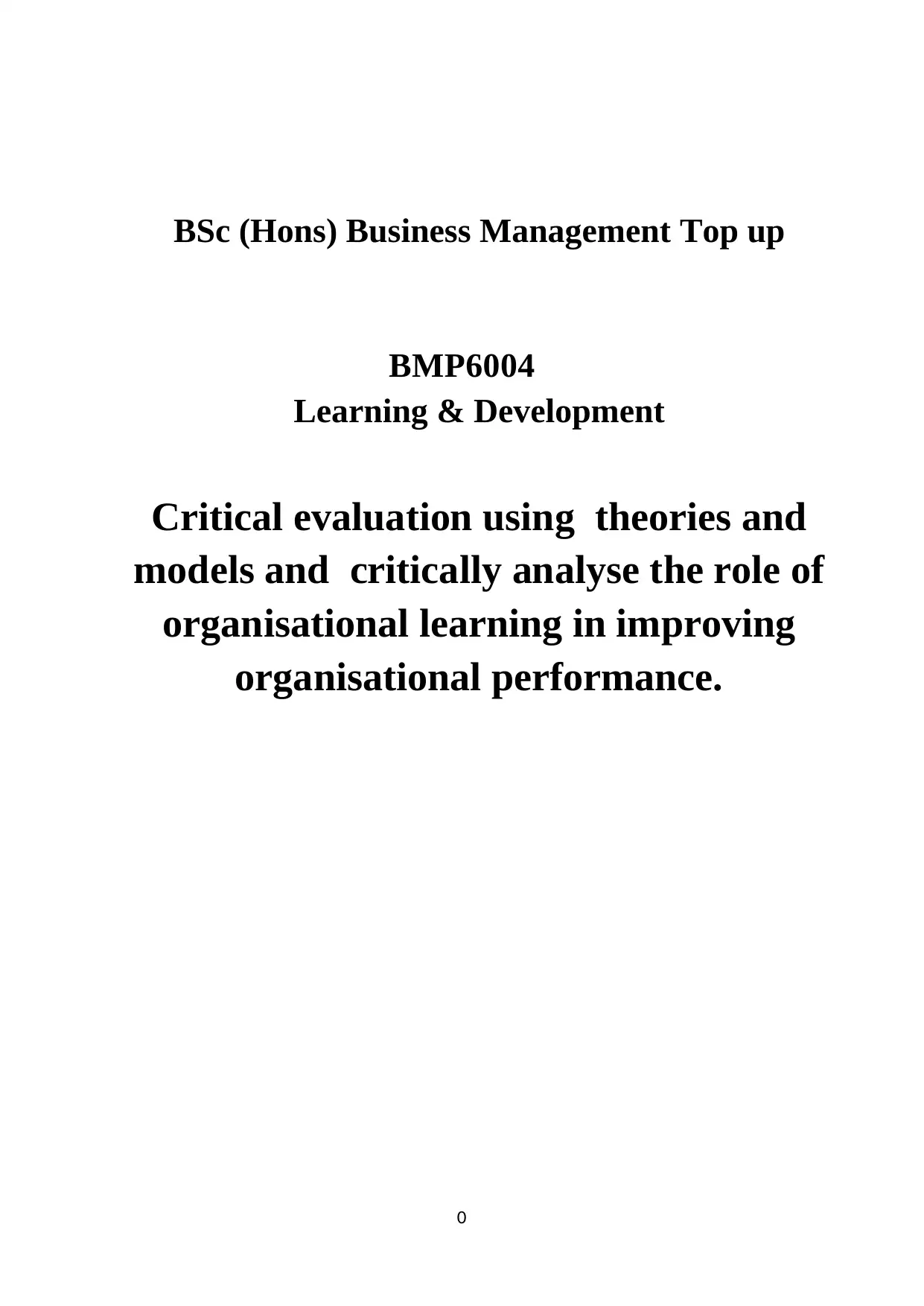
BSc (Hons) Business Management Top up
BMP6004
Learning & Development
Critical evaluation using theories and
models and critically analyse the role of
organisational learning in improving
organisational performance.
0
BMP6004
Learning & Development
Critical evaluation using theories and
models and critically analyse the role of
organisational learning in improving
organisational performance.
0
Paraphrase This Document
Need a fresh take? Get an instant paraphrase of this document with our AI Paraphraser
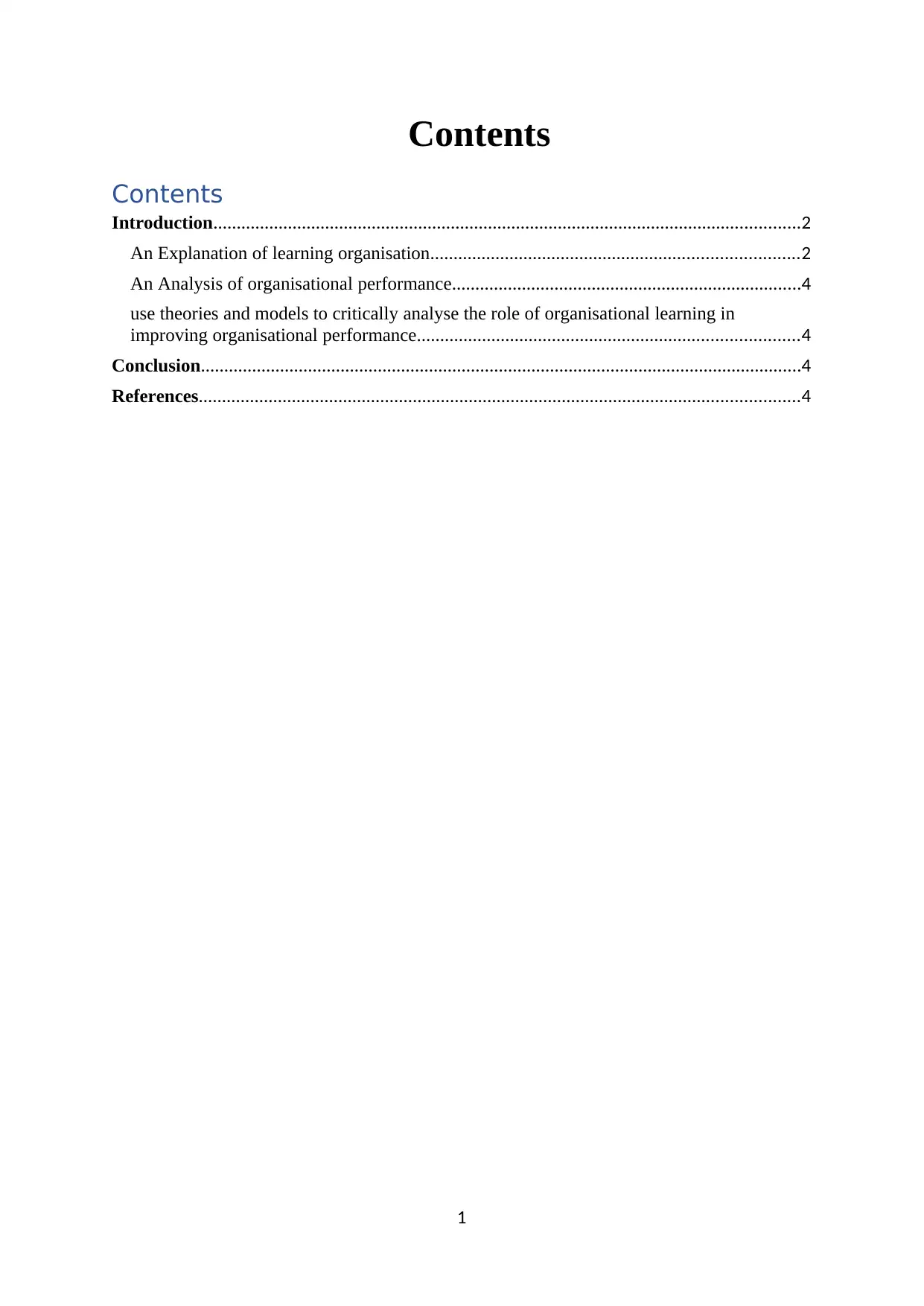
Contents
Contents
Introduction..............................................................................................................................2
An Explanation of learning organisation...............................................................................2
An Analysis of organisational performance...........................................................................4
use theories and models to critically analyse the role of organisational learning in
improving organisational performance..................................................................................4
Conclusion.................................................................................................................................4
References.................................................................................................................................4
1
Contents
Introduction..............................................................................................................................2
An Explanation of learning organisation...............................................................................2
An Analysis of organisational performance...........................................................................4
use theories and models to critically analyse the role of organisational learning in
improving organisational performance..................................................................................4
Conclusion.................................................................................................................................4
References.................................................................................................................................4
1
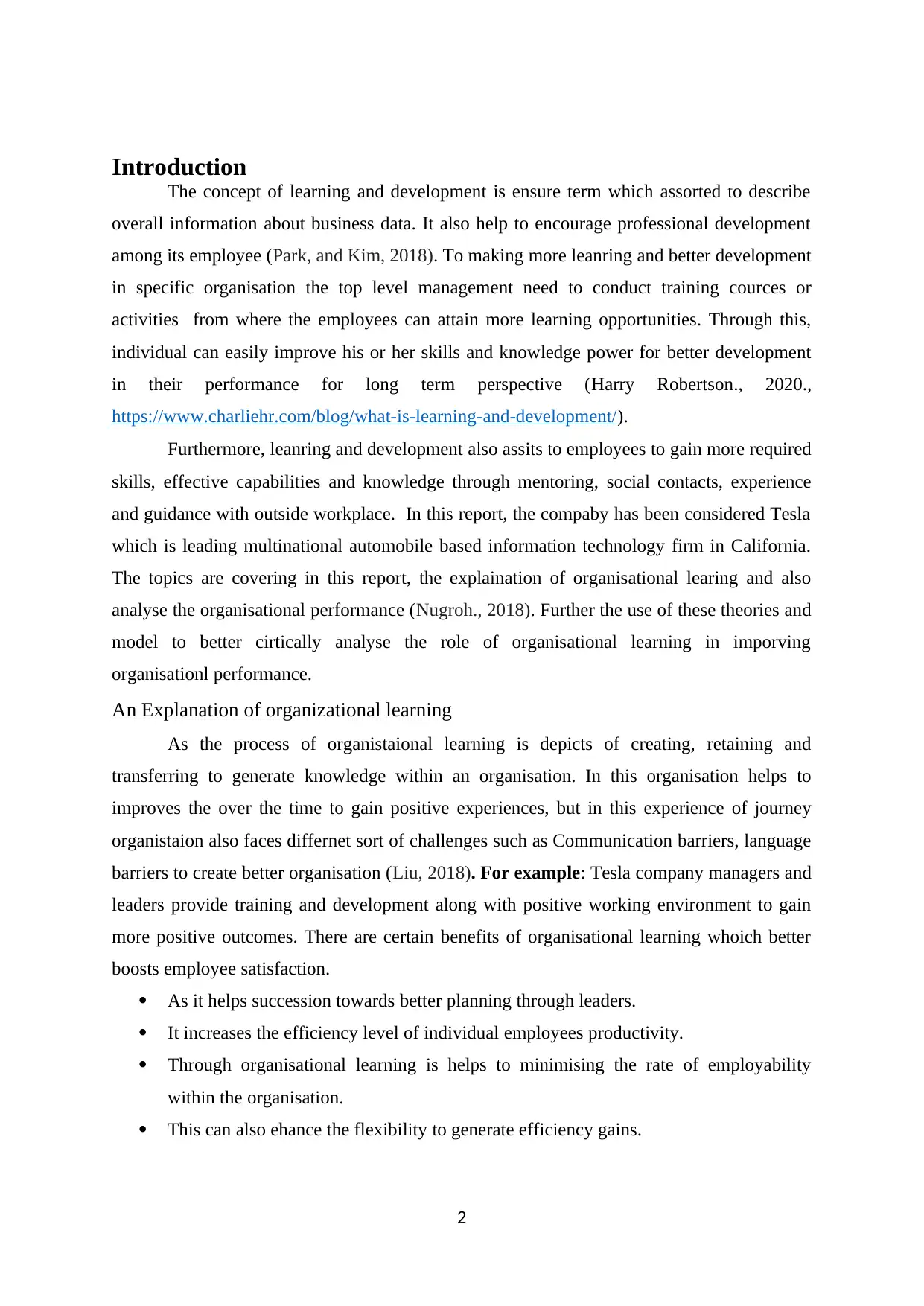
Introduction
The concept of learning and development is ensure term which assorted to describe
overall information about business data. It also help to encourage professional development
among its employee (Park, and Kim, 2018). To making more leanring and better development
in specific organisation the top level management need to conduct training cources or
activities from where the employees can attain more learning opportunities. Through this,
individual can easily improve his or her skills and knowledge power for better development
in their performance for long term perspective (Harry Robertson., 2020.,
https://www.charliehr.com/blog/what-is-learning-and-development/).
Furthermore, leanring and development also assits to employees to gain more required
skills, effective capabilities and knowledge through mentoring, social contacts, experience
and guidance with outside workplace. In this report, the compaby has been considered Tesla
which is leading multinational automobile based information technology firm in California.
The topics are covering in this report, the explaination of organisational learing and also
analyse the organisational performance (Nugroh., 2018). Further the use of these theories and
model to better cirtically analyse the role of organisational learning in imporving
organisationl performance.
An Explanation of organizational learning
As the process of organistaional learning is depicts of creating, retaining and
transferring to generate knowledge within an organisation. In this organisation helps to
improves the over the time to gain positive experiences, but in this experience of journey
organistaion also faces differnet sort of challenges such as Communication barriers, language
barriers to create better organisation (Liu, 2018). For example: Tesla company managers and
leaders provide training and development along with positive working environment to gain
more positive outcomes. There are certain benefits of organisational learning whoich better
boosts employee satisfaction.
As it helps succession towards better planning through leaders.
It increases the efficiency level of individual employees productivity.
Through organisational learning is helps to minimising the rate of employability
within the organisation.
This can also ehance the flexibility to generate efficiency gains.
2
The concept of learning and development is ensure term which assorted to describe
overall information about business data. It also help to encourage professional development
among its employee (Park, and Kim, 2018). To making more leanring and better development
in specific organisation the top level management need to conduct training cources or
activities from where the employees can attain more learning opportunities. Through this,
individual can easily improve his or her skills and knowledge power for better development
in their performance for long term perspective (Harry Robertson., 2020.,
https://www.charliehr.com/blog/what-is-learning-and-development/).
Furthermore, leanring and development also assits to employees to gain more required
skills, effective capabilities and knowledge through mentoring, social contacts, experience
and guidance with outside workplace. In this report, the compaby has been considered Tesla
which is leading multinational automobile based information technology firm in California.
The topics are covering in this report, the explaination of organisational learing and also
analyse the organisational performance (Nugroh., 2018). Further the use of these theories and
model to better cirtically analyse the role of organisational learning in imporving
organisationl performance.
An Explanation of organizational learning
As the process of organistaional learning is depicts of creating, retaining and
transferring to generate knowledge within an organisation. In this organisation helps to
improves the over the time to gain positive experiences, but in this experience of journey
organistaion also faces differnet sort of challenges such as Communication barriers, language
barriers to create better organisation (Liu, 2018). For example: Tesla company managers and
leaders provide training and development along with positive working environment to gain
more positive outcomes. There are certain benefits of organisational learning whoich better
boosts employee satisfaction.
As it helps succession towards better planning through leaders.
It increases the efficiency level of individual employees productivity.
Through organisational learning is helps to minimising the rate of employability
within the organisation.
This can also ehance the flexibility to generate efficiency gains.
2
⊘ This is a preview!⊘
Do you want full access?
Subscribe today to unlock all pages.

Trusted by 1+ million students worldwide
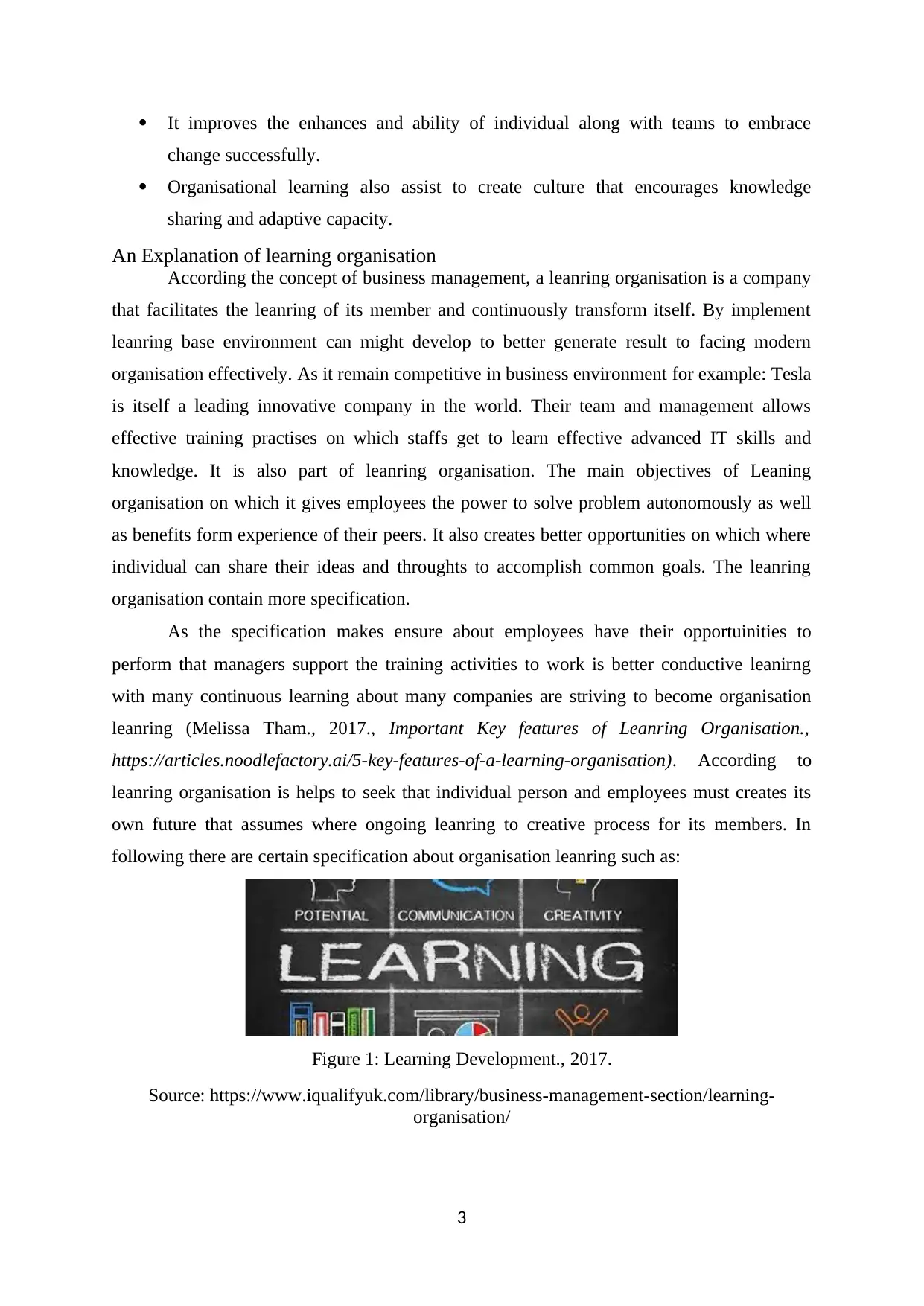
It improves the enhances and ability of individual along with teams to embrace
change successfully.
Organisational learning also assist to create culture that encourages knowledge
sharing and adaptive capacity.
An Explanation of learning organisation
According the concept of business management, a leanring organisation is a company
that facilitates the leanring of its member and continuously transform itself. By implement
leanring base environment can might develop to better generate result to facing modern
organisation effectively. As it remain competitive in business environment for example: Tesla
is itself a leading innovative company in the world. Their team and management allows
effective training practises on which staffs get to learn effective advanced IT skills and
knowledge. It is also part of leanring organisation. The main objectives of Leaning
organisation on which it gives employees the power to solve problem autonomously as well
as benefits form experience of their peers. It also creates better opportunities on which where
individual can share their ideas and throughts to accomplish common goals. The leanring
organisation contain more specification.
As the specification makes ensure about employees have their opportuinities to
perform that managers support the training activities to work is better conductive leanirng
with many continuous learning about many companies are striving to become organisation
leanring (Melissa Tham., 2017., Important Key features of Leanring Organisation.,
https://articles.noodlefactory.ai/5-key-features-of-a-learning-organisation). According to
leanring organisation is helps to seek that individual person and employees must creates its
own future that assumes where ongoing leanring to creative process for its members. In
following there are certain specification about organisation leanring such as:
Figure 1: Learning Development., 2017.
Source: https://www.iqualifyuk.com/library/business-management-section/learning-
organisation/
3
change successfully.
Organisational learning also assist to create culture that encourages knowledge
sharing and adaptive capacity.
An Explanation of learning organisation
According the concept of business management, a leanring organisation is a company
that facilitates the leanring of its member and continuously transform itself. By implement
leanring base environment can might develop to better generate result to facing modern
organisation effectively. As it remain competitive in business environment for example: Tesla
is itself a leading innovative company in the world. Their team and management allows
effective training practises on which staffs get to learn effective advanced IT skills and
knowledge. It is also part of leanring organisation. The main objectives of Leaning
organisation on which it gives employees the power to solve problem autonomously as well
as benefits form experience of their peers. It also creates better opportunities on which where
individual can share their ideas and throughts to accomplish common goals. The leanring
organisation contain more specification.
As the specification makes ensure about employees have their opportuinities to
perform that managers support the training activities to work is better conductive leanirng
with many continuous learning about many companies are striving to become organisation
leanring (Melissa Tham., 2017., Important Key features of Leanring Organisation.,
https://articles.noodlefactory.ai/5-key-features-of-a-learning-organisation). According to
leanring organisation is helps to seek that individual person and employees must creates its
own future that assumes where ongoing leanring to creative process for its members. In
following there are certain specification about organisation leanring such as:
Figure 1: Learning Development., 2017.
Source: https://www.iqualifyuk.com/library/business-management-section/learning-
organisation/
3
Paraphrase This Document
Need a fresh take? Get an instant paraphrase of this document with our AI Paraphraser
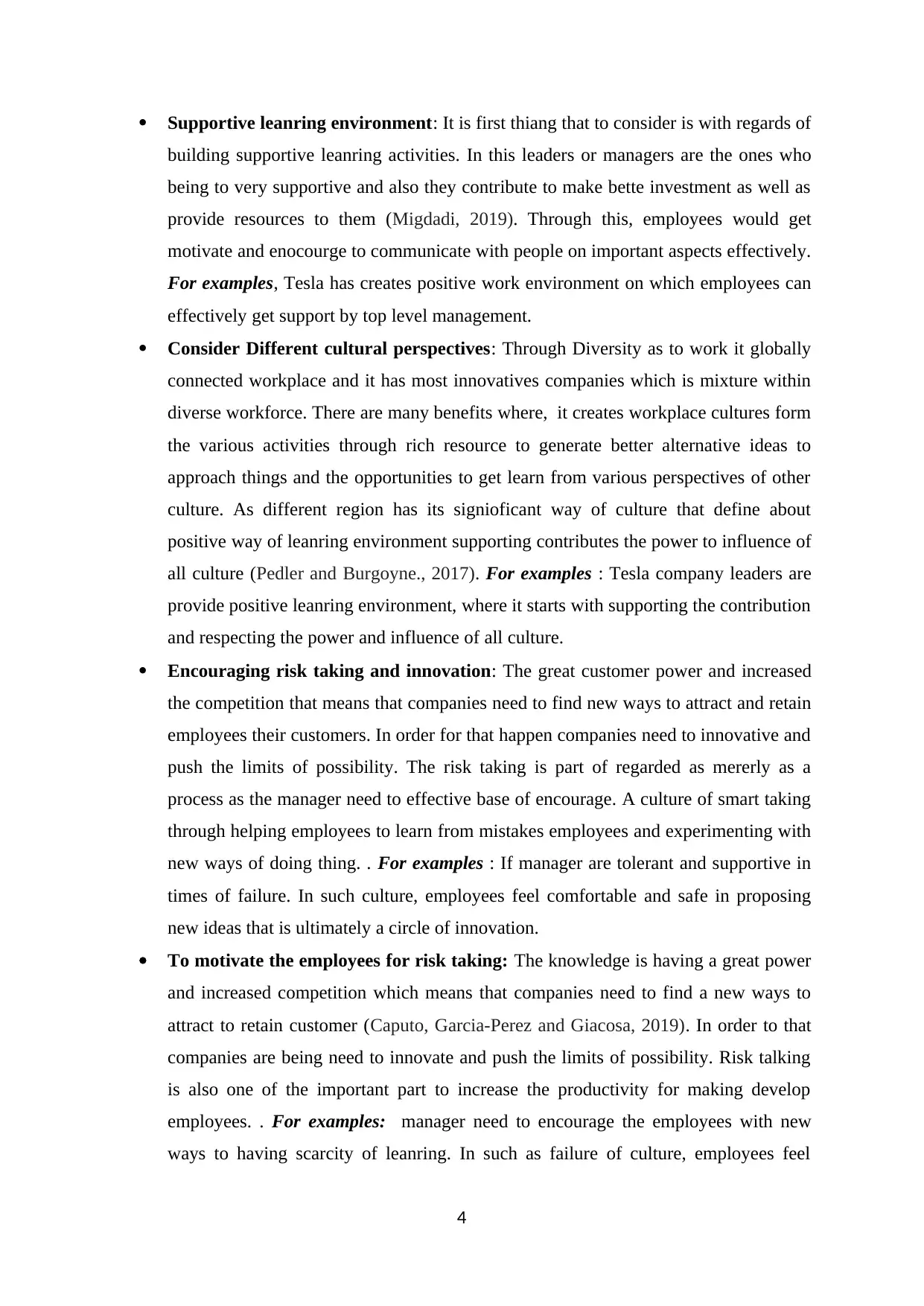
Supportive leanring environment: It is first thiang that to consider is with regards of
building supportive leanring activities. In this leaders or managers are the ones who
being to very supportive and also they contribute to make bette investment as well as
provide resources to them (Migdadi, 2019). Through this, employees would get
motivate and enocourge to communicate with people on important aspects effectively.
For examples, Tesla has creates positive work environment on which employees can
effectively get support by top level management.
Consider Different cultural perspectives: Through Diversity as to work it globally
connected workplace and it has most innovatives companies which is mixture within
diverse workforce. There are many benefits where, it creates workplace cultures form
the various activities through rich resource to generate better alternative ideas to
approach things and the opportunities to get learn from various perspectives of other
culture. As different region has its signioficant way of culture that define about
positive way of leanring environment supporting contributes the power to influence of
all culture (Pedler and Burgoyne., 2017). For examples : Tesla company leaders are
provide positive leanring environment, where it starts with supporting the contribution
and respecting the power and influence of all culture.
Encouraging risk taking and innovation: The great customer power and increased
the competition that means that companies need to find new ways to attract and retain
employees their customers. In order for that happen companies need to innovative and
push the limits of possibility. The risk taking is part of regarded as mererly as a
process as the manager need to effective base of encourage. A culture of smart taking
through helping employees to learn from mistakes employees and experimenting with
new ways of doing thing. . For examples : If manager are tolerant and supportive in
times of failure. In such culture, employees feel comfortable and safe in proposing
new ideas that is ultimately a circle of innovation.
To motivate the employees for risk taking: The knowledge is having a great power
and increased competition which means that companies need to find a new ways to
attract to retain customer (Caputo, Garcia-Perez and Giacosa, 2019). In order to that
companies are being need to innovate and push the limits of possibility. Risk talking
is also one of the important part to increase the productivity for making develop
employees. . For examples: manager need to encourage the employees with new
ways to having scarcity of leanring. In such as failure of culture, employees feel
4
building supportive leanring activities. In this leaders or managers are the ones who
being to very supportive and also they contribute to make bette investment as well as
provide resources to them (Migdadi, 2019). Through this, employees would get
motivate and enocourge to communicate with people on important aspects effectively.
For examples, Tesla has creates positive work environment on which employees can
effectively get support by top level management.
Consider Different cultural perspectives: Through Diversity as to work it globally
connected workplace and it has most innovatives companies which is mixture within
diverse workforce. There are many benefits where, it creates workplace cultures form
the various activities through rich resource to generate better alternative ideas to
approach things and the opportunities to get learn from various perspectives of other
culture. As different region has its signioficant way of culture that define about
positive way of leanring environment supporting contributes the power to influence of
all culture (Pedler and Burgoyne., 2017). For examples : Tesla company leaders are
provide positive leanring environment, where it starts with supporting the contribution
and respecting the power and influence of all culture.
Encouraging risk taking and innovation: The great customer power and increased
the competition that means that companies need to find new ways to attract and retain
employees their customers. In order for that happen companies need to innovative and
push the limits of possibility. The risk taking is part of regarded as mererly as a
process as the manager need to effective base of encourage. A culture of smart taking
through helping employees to learn from mistakes employees and experimenting with
new ways of doing thing. . For examples : If manager are tolerant and supportive in
times of failure. In such culture, employees feel comfortable and safe in proposing
new ideas that is ultimately a circle of innovation.
To motivate the employees for risk taking: The knowledge is having a great power
and increased competition which means that companies need to find a new ways to
attract to retain customer (Caputo, Garcia-Perez and Giacosa, 2019). In order to that
companies are being need to innovate and push the limits of possibility. Risk talking
is also one of the important part to increase the productivity for making develop
employees. . For examples: manager need to encourage the employees with new
ways to having scarcity of leanring. In such as failure of culture, employees feel
4
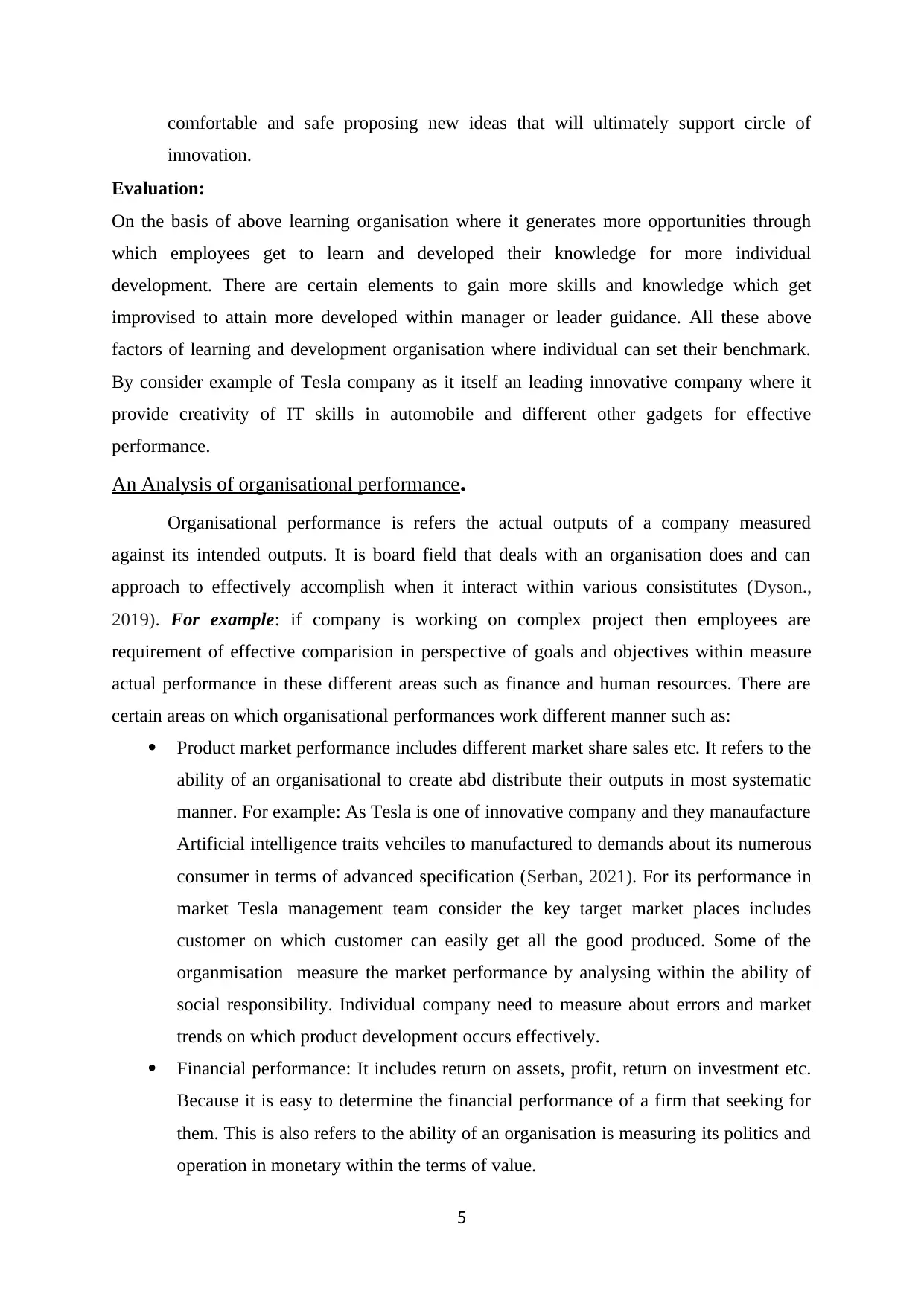
comfortable and safe proposing new ideas that will ultimately support circle of
innovation.
Evaluation:
On the basis of above learning organisation where it generates more opportunities through
which employees get to learn and developed their knowledge for more individual
development. There are certain elements to gain more skills and knowledge which get
improvised to attain more developed within manager or leader guidance. All these above
factors of learning and development organisation where individual can set their benchmark.
By consider example of Tesla company as it itself an leading innovative company where it
provide creativity of IT skills in automobile and different other gadgets for effective
performance.
An Analysis of organisational performance.
Organisational performance is refers the actual outputs of a company measured
against its intended outputs. It is board field that deals with an organisation does and can
approach to effectively accomplish when it interact within various consistitutes (Dyson.,
2019). For example: if company is working on complex project then employees are
requirement of effective comparision in perspective of goals and objectives within measure
actual performance in these different areas such as finance and human resources. There are
certain areas on which organisational performances work different manner such as:
Product market performance includes different market share sales etc. It refers to the
ability of an organisational to create abd distribute their outputs in most systematic
manner. For example: As Tesla is one of innovative company and they manaufacture
Artificial intelligence traits vehciles to manufactured to demands about its numerous
consumer in terms of advanced specification (Serban, 2021). For its performance in
market Tesla management team consider the key target market places includes
customer on which customer can easily get all the good produced. Some of the
organmisation measure the market performance by analysing within the ability of
social responsibility. Individual company need to measure about errors and market
trends on which product development occurs effectively.
Financial performance: It includes return on assets, profit, return on investment etc.
Because it is easy to determine the financial performance of a firm that seeking for
them. This is also refers to the ability of an organisation is measuring its politics and
operation in monetary within the terms of value.
5
innovation.
Evaluation:
On the basis of above learning organisation where it generates more opportunities through
which employees get to learn and developed their knowledge for more individual
development. There are certain elements to gain more skills and knowledge which get
improvised to attain more developed within manager or leader guidance. All these above
factors of learning and development organisation where individual can set their benchmark.
By consider example of Tesla company as it itself an leading innovative company where it
provide creativity of IT skills in automobile and different other gadgets for effective
performance.
An Analysis of organisational performance.
Organisational performance is refers the actual outputs of a company measured
against its intended outputs. It is board field that deals with an organisation does and can
approach to effectively accomplish when it interact within various consistitutes (Dyson.,
2019). For example: if company is working on complex project then employees are
requirement of effective comparision in perspective of goals and objectives within measure
actual performance in these different areas such as finance and human resources. There are
certain areas on which organisational performances work different manner such as:
Product market performance includes different market share sales etc. It refers to the
ability of an organisational to create abd distribute their outputs in most systematic
manner. For example: As Tesla is one of innovative company and they manaufacture
Artificial intelligence traits vehciles to manufactured to demands about its numerous
consumer in terms of advanced specification (Serban, 2021). For its performance in
market Tesla management team consider the key target market places includes
customer on which customer can easily get all the good produced. Some of the
organmisation measure the market performance by analysing within the ability of
social responsibility. Individual company need to measure about errors and market
trends on which product development occurs effectively.
Financial performance: It includes return on assets, profit, return on investment etc.
Because it is easy to determine the financial performance of a firm that seeking for
them. This is also refers to the ability of an organisation is measuring its politics and
operation in monetary within the terms of value.
5
⊘ This is a preview!⊘
Do you want full access?
Subscribe today to unlock all pages.

Trusted by 1+ million students worldwide
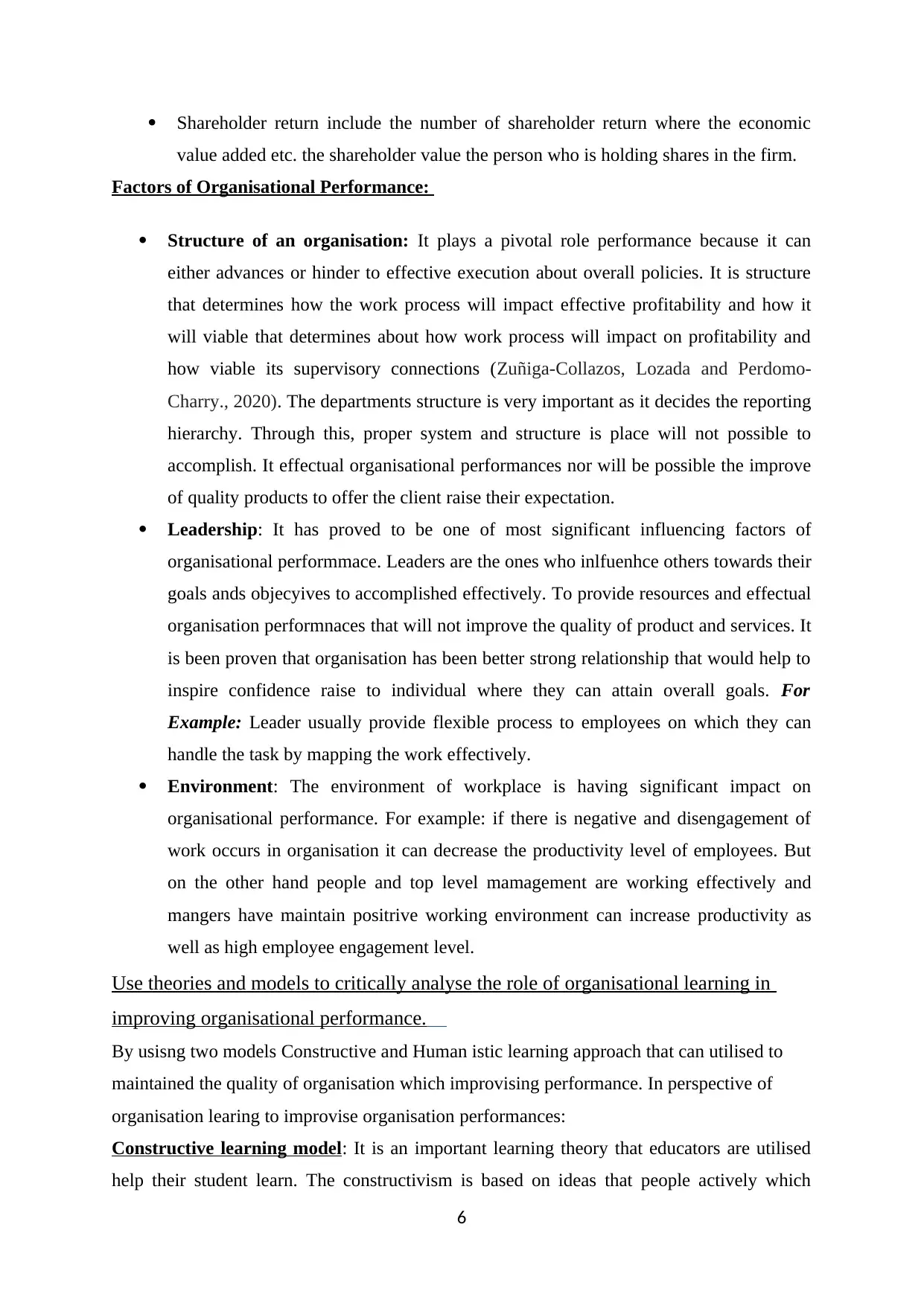
Shareholder return include the number of shareholder return where the economic
value added etc. the shareholder value the person who is holding shares in the firm.
Factors of Organisational Performance:
Structure of an organisation: It plays a pivotal role performance because it can
either advances or hinder to effective execution about overall policies. It is structure
that determines how the work process will impact effective profitability and how it
will viable that determines about how work process will impact on profitability and
how viable its supervisory connections (Zuñiga-Collazos, Lozada and Perdomo-
Charry., 2020). The departments structure is very important as it decides the reporting
hierarchy. Through this, proper system and structure is place will not possible to
accomplish. It effectual organisational performances nor will be possible the improve
of quality products to offer the client raise their expectation.
Leadership: It has proved to be one of most significant influencing factors of
organisational performmace. Leaders are the ones who inlfuenhce others towards their
goals ands objecyives to accomplished effectively. To provide resources and effectual
organisation performnaces that will not improve the quality of product and services. It
is been proven that organisation has been better strong relationship that would help to
inspire confidence raise to individual where they can attain overall goals. For
Example: Leader usually provide flexible process to employees on which they can
handle the task by mapping the work effectively.
Environment: The environment of workplace is having significant impact on
organisational performance. For example: if there is negative and disengagement of
work occurs in organisation it can decrease the productivity level of employees. But
on the other hand people and top level mamagement are working effectively and
mangers have maintain positrive working environment can increase productivity as
well as high employee engagement level.
Use theories and models to critically analyse the role of organisational learning in
improving organisational performance.
By usisng two models Constructive and Human istic learning approach that can utilised to
maintained the quality of organisation which improvising performance. In perspective of
organisation learing to improvise organisation performances:
Constructive learning model: It is an important learning theory that educators are utilised
help their student learn. The constructivism is based on ideas that people actively which
6
value added etc. the shareholder value the person who is holding shares in the firm.
Factors of Organisational Performance:
Structure of an organisation: It plays a pivotal role performance because it can
either advances or hinder to effective execution about overall policies. It is structure
that determines how the work process will impact effective profitability and how it
will viable that determines about how work process will impact on profitability and
how viable its supervisory connections (Zuñiga-Collazos, Lozada and Perdomo-
Charry., 2020). The departments structure is very important as it decides the reporting
hierarchy. Through this, proper system and structure is place will not possible to
accomplish. It effectual organisational performances nor will be possible the improve
of quality products to offer the client raise their expectation.
Leadership: It has proved to be one of most significant influencing factors of
organisational performmace. Leaders are the ones who inlfuenhce others towards their
goals ands objecyives to accomplished effectively. To provide resources and effectual
organisation performnaces that will not improve the quality of product and services. It
is been proven that organisation has been better strong relationship that would help to
inspire confidence raise to individual where they can attain overall goals. For
Example: Leader usually provide flexible process to employees on which they can
handle the task by mapping the work effectively.
Environment: The environment of workplace is having significant impact on
organisational performance. For example: if there is negative and disengagement of
work occurs in organisation it can decrease the productivity level of employees. But
on the other hand people and top level mamagement are working effectively and
mangers have maintain positrive working environment can increase productivity as
well as high employee engagement level.
Use theories and models to critically analyse the role of organisational learning in
improving organisational performance.
By usisng two models Constructive and Human istic learning approach that can utilised to
maintained the quality of organisation which improvising performance. In perspective of
organisation learing to improvise organisation performances:
Constructive learning model: It is an important learning theory that educators are utilised
help their student learn. The constructivism is based on ideas that people actively which
6
Paraphrase This Document
Need a fresh take? Get an instant paraphrase of this document with our AI Paraphraser
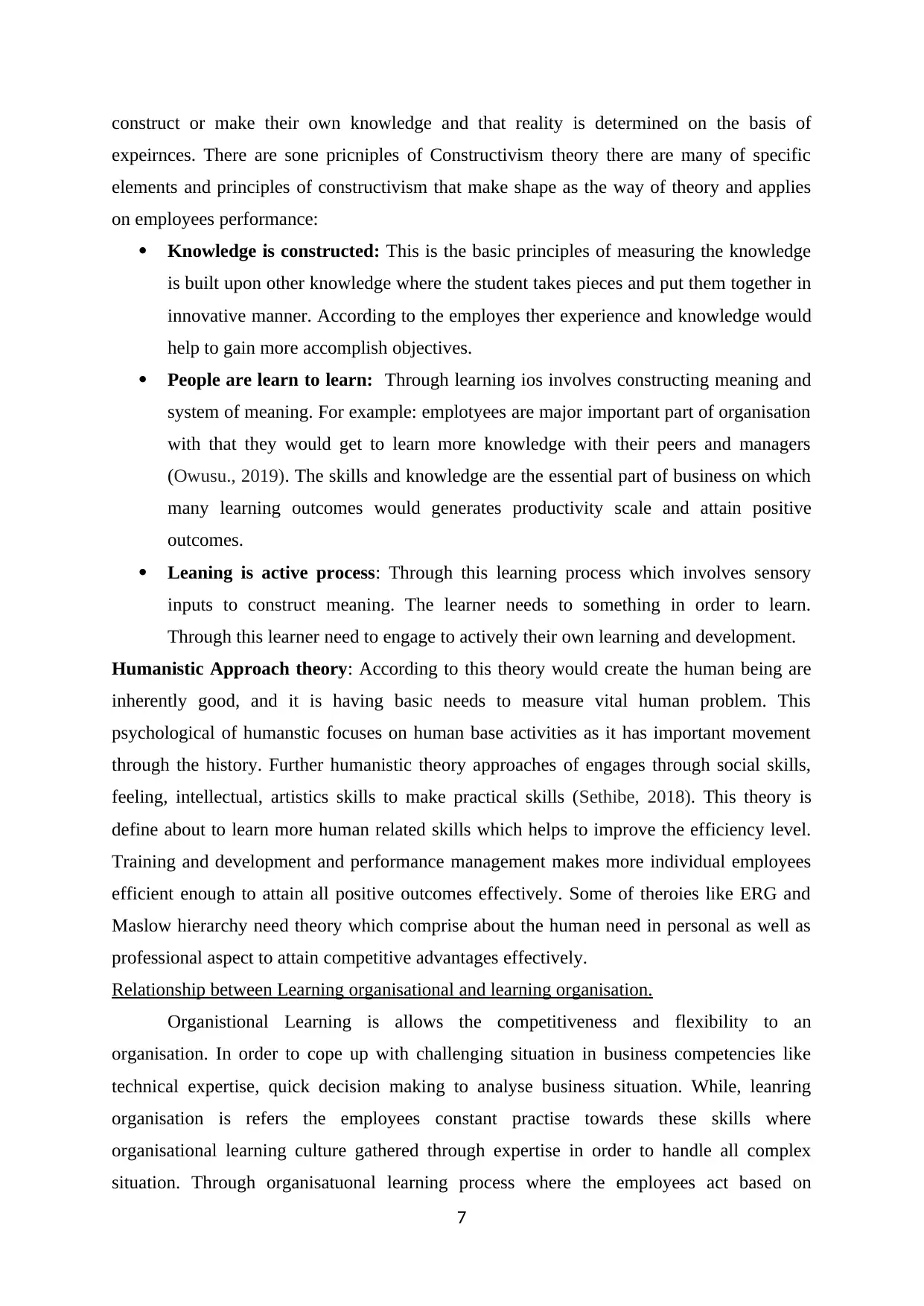
construct or make their own knowledge and that reality is determined on the basis of
expeirnces. There are sone pricniples of Constructivism theory there are many of specific
elements and principles of constructivism that make shape as the way of theory and applies
on employees performance:
Knowledge is constructed: This is the basic principles of measuring the knowledge
is built upon other knowledge where the student takes pieces and put them together in
innovative manner. According to the employes ther experience and knowledge would
help to gain more accomplish objectives.
People are learn to learn: Through learning ios involves constructing meaning and
system of meaning. For example: emplotyees are major important part of organisation
with that they would get to learn more knowledge with their peers and managers
(Owusu., 2019). The skills and knowledge are the essential part of business on which
many learning outcomes would generates productivity scale and attain positive
outcomes.
Leaning is active process: Through this learning process which involves sensory
inputs to construct meaning. The learner needs to something in order to learn.
Through this learner need to engage to actively their own learning and development.
Humanistic Approach theory: According to this theory would create the human being are
inherently good, and it is having basic needs to measure vital human problem. This
psychological of humanstic focuses on human base activities as it has important movement
through the history. Further humanistic theory approaches of engages through social skills,
feeling, intellectual, artistics skills to make practical skills (Sethibe, 2018). This theory is
define about to learn more human related skills which helps to improve the efficiency level.
Training and development and performance management makes more individual employees
efficient enough to attain all positive outcomes effectively. Some of theroies like ERG and
Maslow hierarchy need theory which comprise about the human need in personal as well as
professional aspect to attain competitive advantages effectively.
Relationship between Learning organisational and learning organisation.
Organistional Learning is allows the competitiveness and flexibility to an
organisation. In order to cope up with challenging situation in business competencies like
technical expertise, quick decision making to analyse business situation. While, leanring
organisation is refers the employees constant practise towards these skills where
organisational learning culture gathered through expertise in order to handle all complex
situation. Through organisatuonal learning process where the employees act based on
7
expeirnces. There are sone pricniples of Constructivism theory there are many of specific
elements and principles of constructivism that make shape as the way of theory and applies
on employees performance:
Knowledge is constructed: This is the basic principles of measuring the knowledge
is built upon other knowledge where the student takes pieces and put them together in
innovative manner. According to the employes ther experience and knowledge would
help to gain more accomplish objectives.
People are learn to learn: Through learning ios involves constructing meaning and
system of meaning. For example: emplotyees are major important part of organisation
with that they would get to learn more knowledge with their peers and managers
(Owusu., 2019). The skills and knowledge are the essential part of business on which
many learning outcomes would generates productivity scale and attain positive
outcomes.
Leaning is active process: Through this learning process which involves sensory
inputs to construct meaning. The learner needs to something in order to learn.
Through this learner need to engage to actively their own learning and development.
Humanistic Approach theory: According to this theory would create the human being are
inherently good, and it is having basic needs to measure vital human problem. This
psychological of humanstic focuses on human base activities as it has important movement
through the history. Further humanistic theory approaches of engages through social skills,
feeling, intellectual, artistics skills to make practical skills (Sethibe, 2018). This theory is
define about to learn more human related skills which helps to improve the efficiency level.
Training and development and performance management makes more individual employees
efficient enough to attain all positive outcomes effectively. Some of theroies like ERG and
Maslow hierarchy need theory which comprise about the human need in personal as well as
professional aspect to attain competitive advantages effectively.
Relationship between Learning organisational and learning organisation.
Organistional Learning is allows the competitiveness and flexibility to an
organisation. In order to cope up with challenging situation in business competencies like
technical expertise, quick decision making to analyse business situation. While, leanring
organisation is refers the employees constant practise towards these skills where
organisational learning culture gathered through expertise in order to handle all complex
situation. Through organisatuonal learning process where the employees act based on
7
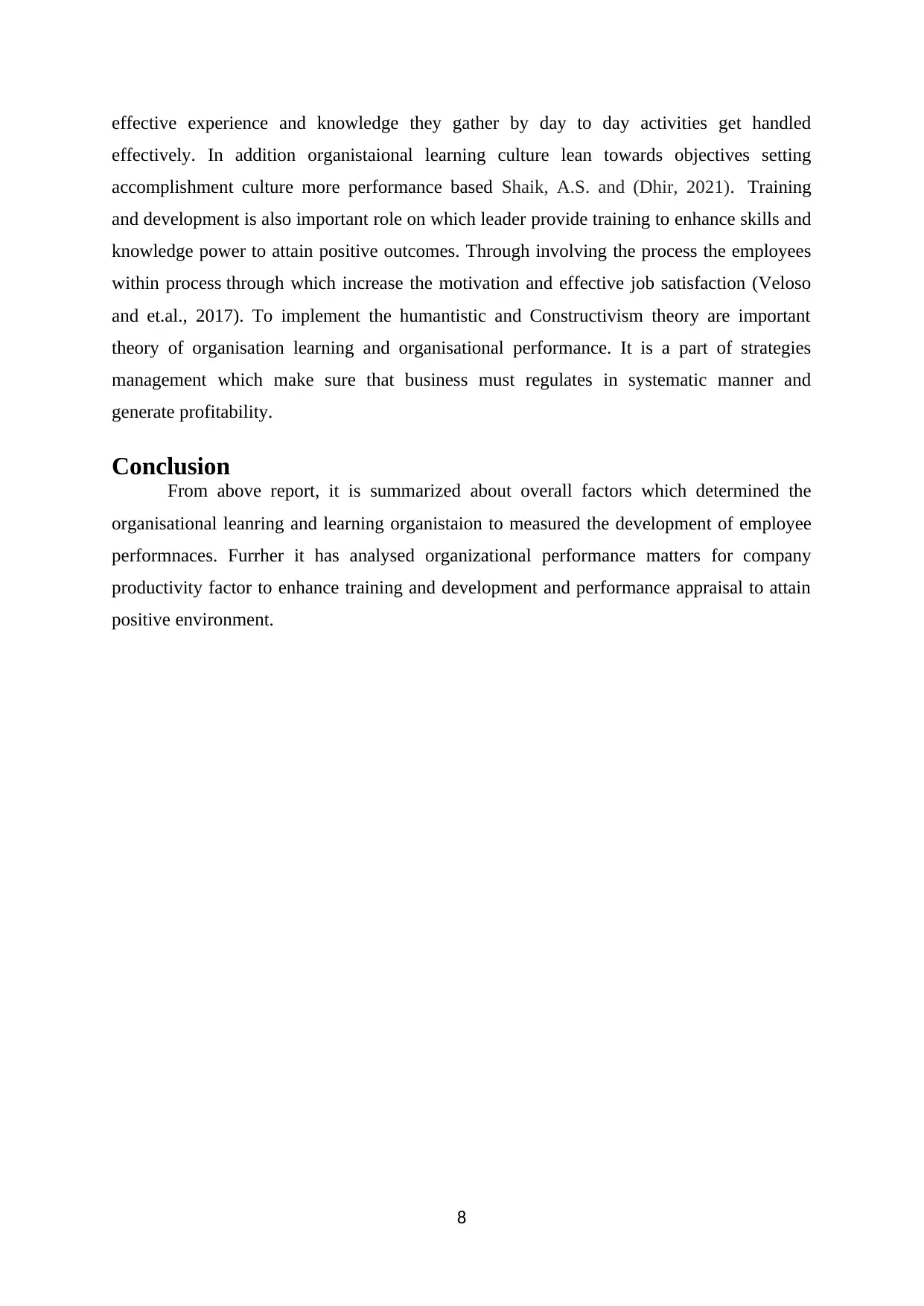
effective experience and knowledge they gather by day to day activities get handled
effectively. In addition organistaional learning culture lean towards objectives setting
accomplishment culture more performance based Shaik, A.S. and (Dhir, 2021). Training
and development is also important role on which leader provide training to enhance skills and
knowledge power to attain positive outcomes. Through involving the process the employees
within process through which increase the motivation and effective job satisfaction (Veloso
and et.al., 2017). To implement the humantistic and Constructivism theory are important
theory of organisation learning and organisational performance. It is a part of strategies
management which make sure that business must regulates in systematic manner and
generate profitability.
Conclusion
From above report, it is summarized about overall factors which determined the
organisational leanring and learning organistaion to measured the development of employee
performnaces. Furrher it has analysed organizational performance matters for company
productivity factor to enhance training and development and performance appraisal to attain
positive environment.
8
effectively. In addition organistaional learning culture lean towards objectives setting
accomplishment culture more performance based Shaik, A.S. and (Dhir, 2021). Training
and development is also important role on which leader provide training to enhance skills and
knowledge power to attain positive outcomes. Through involving the process the employees
within process through which increase the motivation and effective job satisfaction (Veloso
and et.al., 2017). To implement the humantistic and Constructivism theory are important
theory of organisation learning and organisational performance. It is a part of strategies
management which make sure that business must regulates in systematic manner and
generate profitability.
Conclusion
From above report, it is summarized about overall factors which determined the
organisational leanring and learning organistaion to measured the development of employee
performnaces. Furrher it has analysed organizational performance matters for company
productivity factor to enhance training and development and performance appraisal to attain
positive environment.
8
⊘ This is a preview!⊘
Do you want full access?
Subscribe today to unlock all pages.

Trusted by 1+ million students worldwide
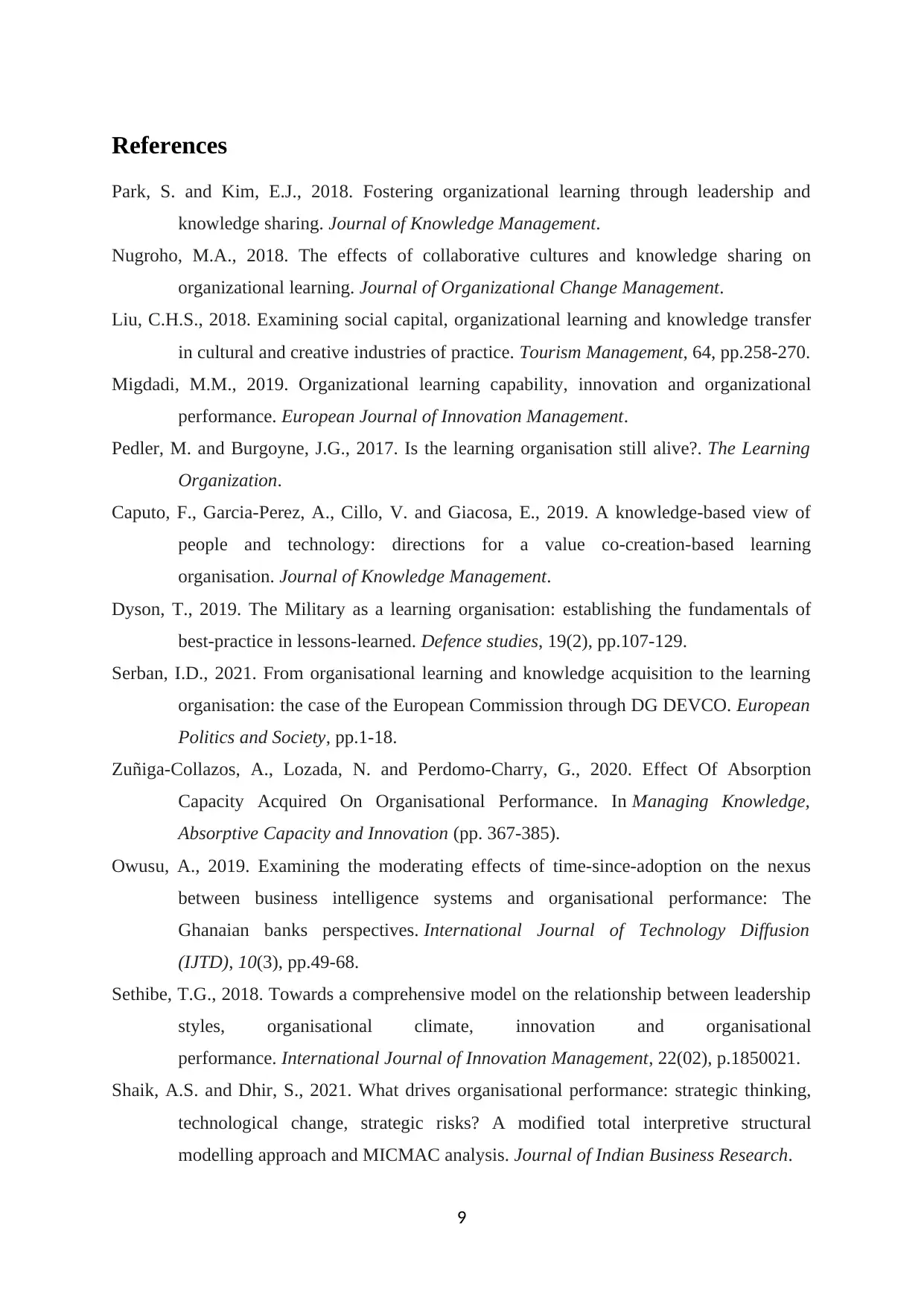
References
Park, S. and Kim, E.J., 2018. Fostering organizational learning through leadership and
knowledge sharing. Journal of Knowledge Management.
Nugroho, M.A., 2018. The effects of collaborative cultures and knowledge sharing on
organizational learning. Journal of Organizational Change Management.
Liu, C.H.S., 2018. Examining social capital, organizational learning and knowledge transfer
in cultural and creative industries of practice. Tourism Management, 64, pp.258-270.
Migdadi, M.M., 2019. Organizational learning capability, innovation and organizational
performance. European Journal of Innovation Management.
Pedler, M. and Burgoyne, J.G., 2017. Is the learning organisation still alive?. The Learning
Organization.
Caputo, F., Garcia-Perez, A., Cillo, V. and Giacosa, E., 2019. A knowledge-based view of
people and technology: directions for a value co-creation-based learning
organisation. Journal of Knowledge Management.
Dyson, T., 2019. The Military as a learning organisation: establishing the fundamentals of
best-practice in lessons-learned. Defence studies, 19(2), pp.107-129.
Serban, I.D., 2021. From organisational learning and knowledge acquisition to the learning
organisation: the case of the European Commission through DG DEVCO. European
Politics and Society, pp.1-18.
Zuñiga-Collazos, A., Lozada, N. and Perdomo-Charry, G., 2020. Effect Of Absorption
Capacity Acquired On Organisational Performance. In Managing Knowledge,
Absorptive Capacity and Innovation (pp. 367-385).
Owusu, A., 2019. Examining the moderating effects of time-since-adoption on the nexus
between business intelligence systems and organisational performance: The
Ghanaian banks perspectives. International Journal of Technology Diffusion
(IJTD), 10(3), pp.49-68.
Sethibe, T.G., 2018. Towards a comprehensive model on the relationship between leadership
styles, organisational climate, innovation and organisational
performance. International Journal of Innovation Management, 22(02), p.1850021.
Shaik, A.S. and Dhir, S., 2021. What drives organisational performance: strategic thinking,
technological change, strategic risks? A modified total interpretive structural
modelling approach and MICMAC analysis. Journal of Indian Business Research.
9
Park, S. and Kim, E.J., 2018. Fostering organizational learning through leadership and
knowledge sharing. Journal of Knowledge Management.
Nugroho, M.A., 2018. The effects of collaborative cultures and knowledge sharing on
organizational learning. Journal of Organizational Change Management.
Liu, C.H.S., 2018. Examining social capital, organizational learning and knowledge transfer
in cultural and creative industries of practice. Tourism Management, 64, pp.258-270.
Migdadi, M.M., 2019. Organizational learning capability, innovation and organizational
performance. European Journal of Innovation Management.
Pedler, M. and Burgoyne, J.G., 2017. Is the learning organisation still alive?. The Learning
Organization.
Caputo, F., Garcia-Perez, A., Cillo, V. and Giacosa, E., 2019. A knowledge-based view of
people and technology: directions for a value co-creation-based learning
organisation. Journal of Knowledge Management.
Dyson, T., 2019. The Military as a learning organisation: establishing the fundamentals of
best-practice in lessons-learned. Defence studies, 19(2), pp.107-129.
Serban, I.D., 2021. From organisational learning and knowledge acquisition to the learning
organisation: the case of the European Commission through DG DEVCO. European
Politics and Society, pp.1-18.
Zuñiga-Collazos, A., Lozada, N. and Perdomo-Charry, G., 2020. Effect Of Absorption
Capacity Acquired On Organisational Performance. In Managing Knowledge,
Absorptive Capacity and Innovation (pp. 367-385).
Owusu, A., 2019. Examining the moderating effects of time-since-adoption on the nexus
between business intelligence systems and organisational performance: The
Ghanaian banks perspectives. International Journal of Technology Diffusion
(IJTD), 10(3), pp.49-68.
Sethibe, T.G., 2018. Towards a comprehensive model on the relationship between leadership
styles, organisational climate, innovation and organisational
performance. International Journal of Innovation Management, 22(02), p.1850021.
Shaik, A.S. and Dhir, S., 2021. What drives organisational performance: strategic thinking,
technological change, strategic risks? A modified total interpretive structural
modelling approach and MICMAC analysis. Journal of Indian Business Research.
9
Paraphrase This Document
Need a fresh take? Get an instant paraphrase of this document with our AI Paraphraser
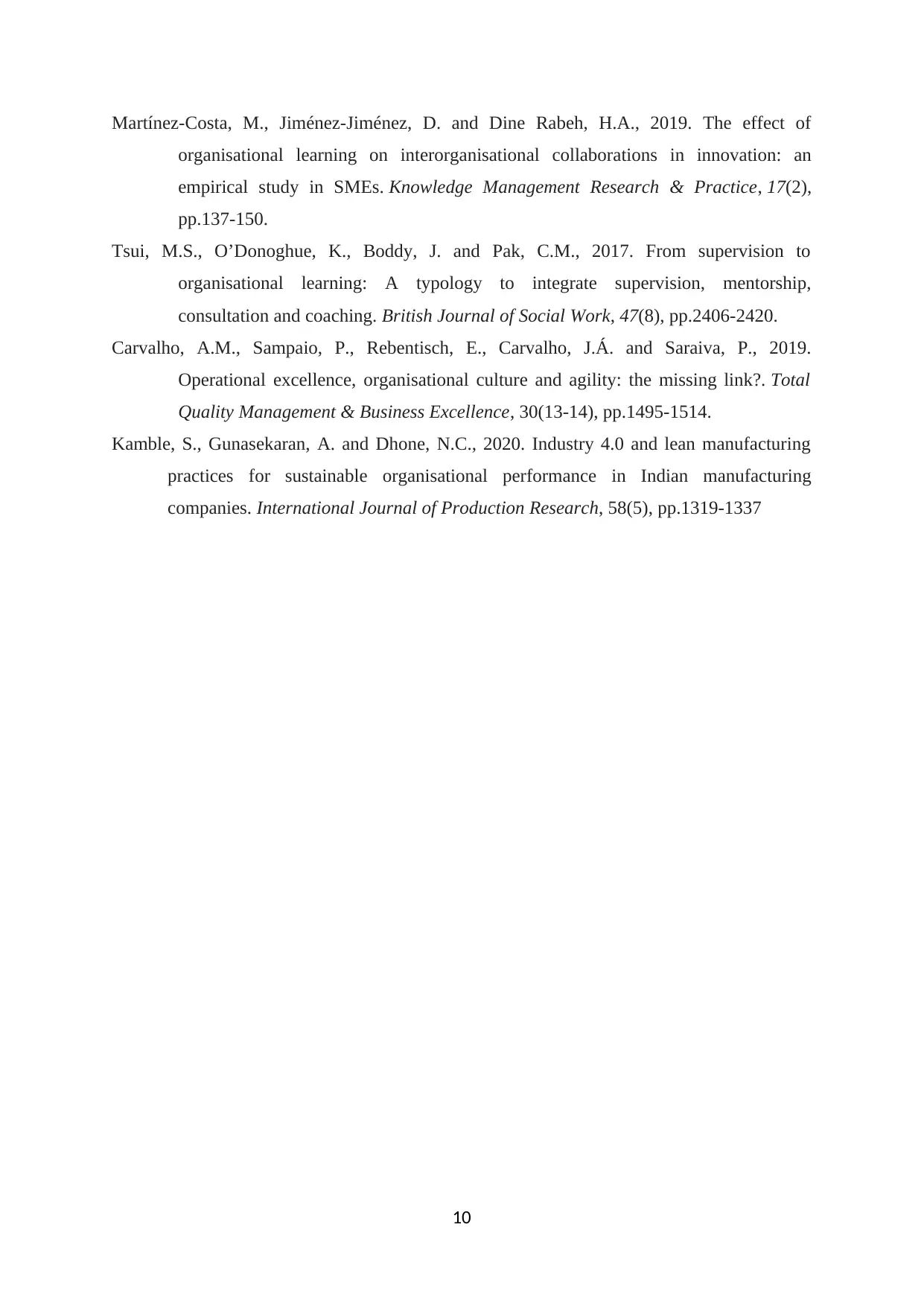
Martínez-Costa, M., Jiménez-Jiménez, D. and Dine Rabeh, H.A., 2019. The effect of
organisational learning on interorganisational collaborations in innovation: an
empirical study in SMEs. Knowledge Management Research & Practice, 17(2),
pp.137-150.
Tsui, M.S., O’Donoghue, K., Boddy, J. and Pak, C.M., 2017. From supervision to
organisational learning: A typology to integrate supervision, mentorship,
consultation and coaching. British Journal of Social Work, 47(8), pp.2406-2420.
Carvalho, A.M., Sampaio, P., Rebentisch, E., Carvalho, J.Á. and Saraiva, P., 2019.
Operational excellence, organisational culture and agility: the missing link?. Total
Quality Management & Business Excellence, 30(13-14), pp.1495-1514.
Kamble, S., Gunasekaran, A. and Dhone, N.C., 2020. Industry 4.0 and lean manufacturing
practices for sustainable organisational performance in Indian manufacturing
companies. International Journal of Production Research, 58(5), pp.1319-1337
10
organisational learning on interorganisational collaborations in innovation: an
empirical study in SMEs. Knowledge Management Research & Practice, 17(2),
pp.137-150.
Tsui, M.S., O’Donoghue, K., Boddy, J. and Pak, C.M., 2017. From supervision to
organisational learning: A typology to integrate supervision, mentorship,
consultation and coaching. British Journal of Social Work, 47(8), pp.2406-2420.
Carvalho, A.M., Sampaio, P., Rebentisch, E., Carvalho, J.Á. and Saraiva, P., 2019.
Operational excellence, organisational culture and agility: the missing link?. Total
Quality Management & Business Excellence, 30(13-14), pp.1495-1514.
Kamble, S., Gunasekaran, A. and Dhone, N.C., 2020. Industry 4.0 and lean manufacturing
practices for sustainable organisational performance in Indian manufacturing
companies. International Journal of Production Research, 58(5), pp.1319-1337
10
1 out of 11
Related Documents
Your All-in-One AI-Powered Toolkit for Academic Success.
+13062052269
info@desklib.com
Available 24*7 on WhatsApp / Email
![[object Object]](/_next/static/media/star-bottom.7253800d.svg)
Unlock your academic potential
Copyright © 2020–2025 A2Z Services. All Rights Reserved. Developed and managed by ZUCOL.



